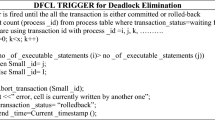Abstract
A major concurrency control problem that we have to cope in multidatabase systems is the global deadlock detection and resolution problem. This detection must take into account the autonomy of local systems, which make impossible the visibility of the state of local transactions. A well-known approach to detect such deadlocks, called potential global deadlocks, is one based on the potential conflict graph (PCG) appropriate for the multidatabase transaction model with a global commit protocol. This classical transaction model is very constraining for applications manipulating great volumes of information, and where subtransaction terminations (commit or abort) of global transactions are not totally dependant. In this paper we present an effective potential global deadlock characterization, and an efficient potential global deadlock detection algorithm, in multidatabase systems with an extended transaction model more suited for such applications.
Similar content being viewed by others
References
R. Baldoni and S Salzao. Deadlock detection in multidatabase systems: a performance analysis. Distributed Systems Engineering Journal, 4(4), 1997.
N. Barghouti and G. Kaiser. Concurrency control in advanced database applications. ACM Computing Survey, 23(3):269–317, 1991.
K. Barkaoui and M. Minoux. Deadlocks and traps in petri nets as horn-satisfiability. Solutions and some related polynomially solvable problems. Discrete Applied Mathematics, 29(4), 1990.
E. Bertino, G. Chiola, and L. V. Mancini. Deadlock Detection in the Face of Transaction and Data Dependencies in Advanced Transaction Models, 19th Int. Conf. on Application and Theory of Petri Nets, Lisbon, Portugal, LNCS, Springer, Verlag, June 1998.
Y. Breitbart, W. Litwin, et A. Silberschatz. Deadlock problems in multidatabase environment: In Proc. of the IEEE COMPCON, IEEE CS Press, pp. 145–151, 1991.
P. Chrysanthis and K. Ramamritham, ACTA: a framework for specifying and reasoning about transaction structure behavior. In Readings in Database Systems, 2nd ed., Morgan Kaufmann, pp. 335–344, 1994.
A. K. Elmagarmid and W. Du. A paradigm for concurrency control in heterogeneous distributed database systems. In Proceedings of the 6th International Conference on Data Engineering, pp. 37–46, Los Angeles, CA, February 1990.
H. Garcia-Molina and K. Salem. Saga. In Proceedings of the ACM International Conference on Management on Data (SIGMOD'87), pp. 249–259, 1987.
T. Hermann and K. Chandy. A Distributed procedure to detect AND-OR deadlock. TR LCS-8301. Dept. of Computer Science, Technical report University of Texas, Austin, 1983.
S. Jajodia and L. Kerchsberg, editors, Advanced Transaction Model and Architectures. Kluwer Academic Publishers, 1997.
L. Mancini, I. Ray, E. Bertino, and S. Jajodia, Flexible commit protocols for advanced transaction processing. In Advanced Transaction Models and Architectures, S. Jajodia and L. Kerschberg, eds., pp. 91–124, Kluwer Academic Publishers, 1997.
Author information
Authors and Affiliations
Rights and permissions
About this article
Cite this article
Barkaoui, K., Benamara, R. On Concurrency Control in Multidatabase Systems with an Extended Transaction Model. The Journal of Supercomputing 24, 193–202 (2003). https://doi.org/10.1023/A:1021707111118
Issue Date:
DOI: https://doi.org/10.1023/A:1021707111118




